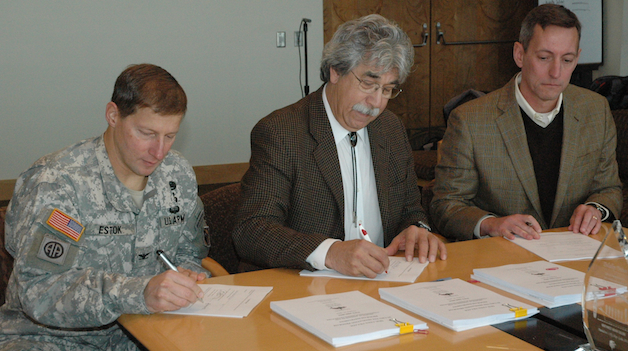
— image credit: Kirk Boxleitner
Kirk Boxleitner, Marysville Globe
TULALIP — Representatives of the Tulalip Tribes, the U.S. Army Corps of Engineers and the Environmental Protection Agency sat down together on Tuesday, Nov. 26, to officially establish the first Native American In-Lieu Fee Program in the nation, for aquatic resource impacts and compensatory mitigation.
Tulalip Tribal Chair Mel Sheldon Jr. was joined by Col. Bruce Estok, district commander and engineer of the Army Corps of Engineers’ Seattle District, and David Allnutt — director of the Office of Ecosystems, Tribal and Public Affairs for Region 10 of the EPA — in signing an ILF Program Instrument for Quil Ceda Village, with the purpose of providing compensation for unavoidable impacts to wetlands and other aquatic resources, resulting from construction projects within the boundaries of Quil Ceda Village itself.
“This is a very significant event,” Estok said. “With the Tribes’ leadership, this will allow high-quality mitigation for their aquatic resources, to help them develop their environment.”
Sheldon credited Terry Williams, the Fisheries and Natural Resources Commissioner for the Tulalip Tribes, with seeing this program through since he started working with the Tribes.
“This represents the culmination of years of work,” Sheldon said. “This gives us the flexibility to pursue our other economic programs, and shows respect for the Tribes’ sovereignty.”
Sheldon went so far as to describe the Quil Ceda Village ILF Program as vital to the future of the Tulalip Tribes.
“Only by protecting and restoring our tribal watershed lands do we fulfill our obligations to future generations, to leave them a healthy, productive environment, while also allowing us to develop and manage our lands, to yield a stronger and even more diverse tribal economy,” Sheldon said. “Our In-Lieu Fee Program is the first by a federally recognized tribe, and we believe that our record on environmental restoration, protection and natural resource management has prepared us to implement and administer this smart and effective program, by providing high-quality mitigation within a watershed approach.”
The ILF Program will use a watershed approach to locate mitigation projects, and provide consolidated mitigation targeting specific priority habitat, water quality and hydrology functions, based on the critical needs of each sub-basin within the Quil Ceda Creek watershed.
“The Corps believes that effective ILF Programs are vital to helping it protect the aquatic environment, efficiently administer our regulatory program, and provide the regulated public with fair, timely and reasonable decisions,” said Gail Terzi, a mitigation specialist for the Army Corps of Engineers. “ILF Programs are very intentional in how they embrace a watershed approach and, as such, are optimal tools for addressing watershed needs.”
“The EPA commends the Tulalip Tribes for this proactive move to protect the Quil Ceda watershed,” Allnutt said. “Watersheds and aquatic resources are a valuable part of the broader ecosystem in this area, and this program will result in thoughtful decision-making to protect this tribal resource.”
“We may not realize how big this is now, but generations down the road will be thanking us,” Sheldon said.
